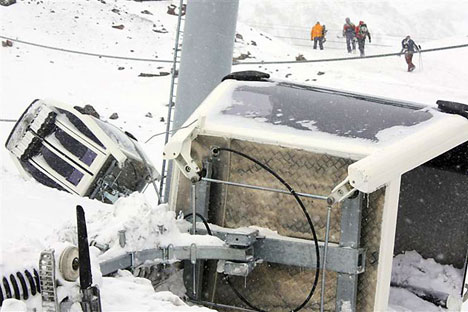
Fewer Killed in the North Caucasus Last Year, but Overall Situation Remains Unchanged
Publication: Eurasia Daily Monitor Volume: 9 Issue: 13
By:

The Kavkazsky Uzel (Caucasian Knot) website has published the statistics for casualties in the North Caucasus in 2011. The figures, compiled using open sources, allow us to draw a range of interesting conclusions. First of all, it is peculiar that the number of those wounded in armed clashes and bombings was lower than the number of those killed. Thus in Kabardino-Balkaria there were 129 killed but only 44 wounded. Second, it is odd that in Chechnya, advertised by the Russian authorities as a peaceful and prospering republic, there were 201 victims last year, of whom 95 were killed and 106 injured.
In 2010, the overall figure for victims of the conflict in the North Caucasus was 1,710 – 754 people killed and 956 wounded. Among those killed were 354 rebels, 180 police officers and 180 civilians. While the overall number of victims decreased by one-third in 2011, the number of those killed – 733 – stayed at about the same level in 2011. The lower percentage of victims does not indicate a lowering of tensions in the region, nor does it reflect the real picture of the past year. Throughout the year, Russian officials were forced to admit on numerous occasions that the situation in the North Caucasus is dire (www.novoteka.ru/sevent/10885354). The Russian people agree with the government on this: nearly a third of the respondents surveyed by the Levada Center stated that the situation in the region remained tense and one in four of those surveyed expected the situation to worsen (www.levada.ru/27-10-2011/nord-ost-i-obstanovka-na-severnom-kavkaze).
The overall decrease in the number of casualties in the North Caucasus was a result of developments in Kabardino-Balkaria and Ingushetia, where the killing of almost all of the leaders of the jamaats led to a decrease in the number of casualties. The Ingush jamaat has essentially failed to regain the levels of strength that it enjoyed under its long-time leader, Emir Magas (aka Yevloev-Taziev). Under the current leader of the Ingushetia’s Sharia Jamaat, Emir Daud, there have been practically no significant attacks since the spring of 2010. Most likely, this jamaat is still undergoing reorganization and revival in the wake of Emir Magas’ arrest and the killings and arrests of several other leading commanders of the Ingush jamaat.
The Kabardino-Balkarian jamaat also markedly reduced its activities. The republic ranked third in terms of casualties in 2011, yielding second place to Chechnya. An abrupt decrease in rebel attacks in Kabardino-Balkaria took place during the period May to October 2011. Despite the decrease, there were still 173 victims of militant attacks, most of which occurred in the first months of 201, before the Russian security services wiped out nearly the entire leadership of the jamaat between March and May. In the second half of 2011, the Kabardino-Balkarian jamaat was busy with reorganization and self-preservation, given that all its top leaders could not have been killed without treachery in the rebels’ own ranks. This resulted in a lengthy process to select the new emir of Kabardino-Balkaria. On September 9, in coordination with Doku Umarov, Alim Zankishiev (aka Ubaidallah) became the new leader of the rebels in Kabardino-Balkaria. An ethnic Balkar, Zankishiev is 30 years old and comes from the village of Verkhnyaya Zhemala (www.djamaattakbir.com/2011/09/blog-post_6867.html). Emir Ubaidallah is on the Russian federal wanted list on charges of attacking police officers (https://pravitelstvokbr.ru/k-br%5Ckbr-main.nsf/html/ZAUCHASTIEVRYADAHNVF). Even the name of the jamaat was changed: formerly known as the United Jamaat of Kabarda, Balkaria and Karachay, it is now called Jamaat Takbir.
Emir Ubaidallah was not unknown among the rebels: he led the Nalchik sector of the jamaat prior to his appointment. In the several weeks following his appointment, the new emir appointed new people to all sectors of the jamaat. This signaled that the reorganization period was quick and painless and the jamaat retained the bulk of its personnel. Arguably, the December 17 assassination of Vadim Sultanov, a police colonel from the center “E”, was the most notorious killing of the year in Kabardino-Balkaria. Rebel websites declared that Sultanov was the masked person who had made videotaped statements against the militants on behalf of Kabardino-Balkaria’s civilians. The colonel claimed he represented an organization called Chernye Yastreby (the Black Hawks), which would hunt down the militants and members of their families (https://kavpolit.com/padenie-chernogo-yastreba/). However, officials tried to reject this explanation (https://rss.novostimira.com/n_1971821.html).
But the fact that this mythical organization did not carry out a single action in a year confirms that it likely originated in the police structures. The group gave frequent interviews to Moscow TV channels, and reporters rather easily found and conducted interviews with its members, but it increasingly looked like publicity for a non-existent organization (www.kasparov.ru/material.php?id=4D75FB569D76E). If it is confirmed that the authorities were behind the Black Hawks, it will mark the first confirmed case of the government carrying out extralegal executions under the guise of nationalism. The Black Hawks did not hide their antipathy toward non-Kabardins, alleging that Balkars bore all the responsibility for the Kabardino-Balkarian jamaat’s activities and were the primary driving force in the movement. In fact, the Kabardin component of the Yarmuk jamaat (aka Takbir) is hardly any smaller than the Balkar component. We should not forget that for several years, an ethnic Kabardin, Anzor Astemirov (aka Emir Seifullah), was the primary ideologue of Kabardino-Balkarian jamaat and of the entire North Caucasian armed underground. Astemirov was killed in Nalchik on March 24, 2010. He was the initiator of the North Caucasian resistance movement’s reorganization into an Islamic organization – the Caucasus Emirate.
Thus the 2011 statistics indicate that although it was a successful year for the Russian security services, little changed in the general picture of the armed resistance, except in Kabardino-Balkaria. Even in the latter, however, the latest trend appears to be going against Russian interests.




